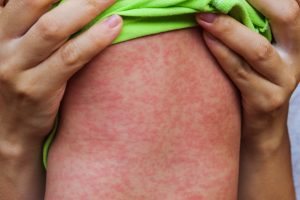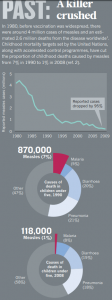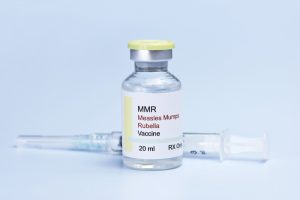Writtern by Home Doctor Brisbane Team
Your go-to guide for measles
Measles has a long history across the world, particularly in the mid-1900s when almost every person had the disease. Since then, immunisations have dramatically decreased the number of reported cases all over the globe, including Australia.
So, just how far have we come since these outbreaks, and what else do you need to know about the disease? Here’s what our after-hours home doctors have put together.
What is measles?
Measles is a highly infectious disease that is usually spread through air-borne droplets of the virus. It can sometimes have serious complications including pneumonia and encephalitis (known as brain inflammation).
Although measles is quite rare in Australia because of the use of the measles vaccine, it remains the fifth highest cause of both illness and death in children worldwide.
How infectious is measles?
Measles is one of the most easily spread of all human infections. Simply being in the same room as a person with measles can result in the transmission of infection, particularly for those not immunised. In fact, roughly 9 out of 10 people who come into contact with the virus will catch it if they are not vaccinated or immune.
It can also spread through direct contact with mucous membranes of an infected person, and by touching articles freshly soiled with the mucous and saliva of an infected person.
Symptoms
It is important to remember it takes approximately 10 days for signs of becoming sick with measles to be exposed, and it takes a further 14 days after exposure for a rash to appear.
Initial symptoms of measles include:
- Fever
- Tiredness
- General discomfort
- Runny nose
- Cough
- Sore red eyes.
These symptoms typically last for a few days before a red blotchy rash will appear. This rash will usually start on the face (for one to two days) before spreading down to the body (and will last for four to seven days).
Causes
Measles is caused by a type of virus called paramyxovirus which spreads between person to person via ‘droplets’ from coughing or sneezing. It is common to catch measles by breathing in these droplets or, if the droplets have settled on a surface, by touching the surface and then placing your hands near your nose or mouth. The measles virus can survive on surfaces for a few hours.
Our after-hours home doctors stress that once inside your body, the virus multiplies in the back of your throat and lungs before spreading throughout your body, including to your respiratory system and skin.
Source: nature.com
Treatment
There is no specific treatment for measles, though it is recommended to rest, drink plenty of fluids and take paracetamol for fever if required.
A case of measles without complications typically lasts around 14 days and most people make a full recovery. Remember as the illness is viral, antibiotics will not work.
The aim of treatment is to ease symptoms and reduce the risk of complications.
Examples include:
- Bed rest
- Plenty of fluids
- Paracetamol to reduce pain and fever
- Isolation to reduce the risk of transmission.
Occasionally, measles develops into a serious disease that requires urgent treatment and can be life threatening. As well as this, some people can die from complications even if they receive prompt medical attention.
Depending on the complication, treatment can include:
- Hospitalisation
- Supportive care – for example, to maintain hydration, and to check for fever and infection
- Antibiotics – to treat bacterial infection.
Prevention
The best protection against measles is immunisation with two doses of the MMR vaccine (measles, mumps and rubella).
The MMR vaccine should be given to children at age 12 months and a second dose as MMRV (measles, mumps, rubella and varicella) should be given at 18 months of age.
If not already immune, all children and adults born during or after 1966 should be vaccinated with two doses of the MMR vaccine (make sure to consult with your doctor for more information),
The vaccine is usually administered in two doses and at least four weeks apart. It is safe to have the vaccine more than once, so people who are unsure should be vaccinated.
Immunisation has dramatically reduced the incidence of measles in Europe but despite overall high immunisation coverage, there continues to be frequent outbreaks. Globally, measles remains a leading cause of childhood death and an estimated 160,000 children die each year from complications of the disease.
People with measles should stay at home until they are no longer infectious (until four days after the rash starts) to avoid the illness spreading.
Notifiable disease
In Australia, measles is a notifiable disease, meaning doctors, hospitals and laboratories must inform the State’s Department of Health of a diagnosis.
Notification is confidential, and the Department of Health staff will talk to you or your doctor to find out how the infection occurred, identify other people at risk of infection, and let you know about immunisation.
They may also give advice on whether you or your child needs to stay away from work, school or group gatherings.
Current status of measles in Australia
In the pre-vaccine era, measles affected almost all of the population at some stage of their lives. Since then, immunisation has proven effective in preventing the disease.
Statistics show since 1993, the number of cases of measles in Australia has fallen considerably. Though, there has been spikes in notification rates and hospitalisation rates, for example between 2000 and 2011. The total number of cases between these years was 990, with an average annual rate of 0.4 per 100,000 people.
Unsurprisingly, children under the age of four were the most susceptible group (especially newborns under one year). The second highest increase of numbers was observed in adolescents (average annual rate of 0.7 per 100,000 people) and young adults (average annual rate of 0.8 per 100,000 people).
Key facts you need to know about measles from the World Health Organisation
- If a pregnant woman gets measles, there is an increased risk of miscarriage, early labour or low birth weight in newborns
- Even though there is a vaccine available, measles is one of the leading causes of death among young children
- Between 2000 and 2016, the measles vaccination resulted in an 84 per cent drop in deaths from the disease worldwide
- Statistics have shown that in 2016, approximately 85 per cent of children received one dose of the measles vaccine before their first birthday via routine health services – an increase from 72 per cent reported in 2000
- There is a lower risk of death from measles for children, than adults and infants
- As a result of the measles vaccination, an estimated 20.4 million deaths were prevented between 2000 and 2016. This makes the measles vaccine one of the most effective in the health industry.
- In 2016, there was a reported 89,780 deaths across the world. This was the first year the measles death rate had fallen below 100,000 per year.
- Along with death, measles can cause brain inflammation, severe diarrhea and life-threatening pneumonia.
- Before the measles vaccine was introduced in 1963, there was an estimated 2.6 million deaths globally every year. As well this, there were major epidemics every two to three years.







